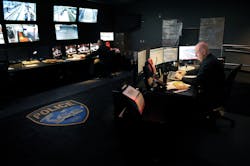3 Ways Cities Can Strengthen Their Public Safety Strategy
As concerns around public safety and security have risen over the years, cities and law enforcement are doing everything in their power to prepare for any situation that might come their way. Through the use of big data and analytics, along with smarter transportation management systems and innovative public safety strategies, city governments can successfully host major events, deal with unpredictable natural disasters, and even reduce unnecessary citizen service disruptions - all by managing risk.
A major portion of this risk management strategy is achieved through sharing the right data across multiple stakeholders and agencies. This task can seem quite daunting, especially when considering how much extensive cooperation and coordination across many departments it requires.
Special events often times attract very large crowds, and natural disasters present unpredictable outcomes that create logistical, safety and transportation challenges on a massive scale. It is essential for cities to find an intelligent software solution that works directly with special response groups to connect them with command center communications and real-time situational awareness, enabling increased collaboration and allowing authorized users to view and manage situations in real-time. Cities need to be able to share video and other important data with security teams around the city such as public safety agencies, the police and fire departments, major venues, stadiums, hospitals and medical centers.
Below are three key takeaways that city governments can apply to building their public safety strategy.
Increase Collaboration
Government agencies can easily become siloed - especially at the city level. When stakeholders and organizational leaders decide to integrate their technology and work together, this creates an efficient and powerful database that involves every aspect of the city’s needs.
Integrating multiple subsystems, sensors, and devices into a unified user interface create one common platform rather than numerous disparate applications, creating a faster process for decisions to be made. When operation centers have to contact multiple disparate sites for real-time updates, it increases the risk of mismanaged information and human error.
With the help of a converged security platform, decision makers can respond to everyday events and more serious risks in a more efficient manner by reducing the amount of time and effort operators spend looking at multiple screens to gather, sort and analyze data.
Rapid-Response Planning
Mobility is crucial for a public safety strategy. Operational databases should also be browser-based so that they’re available anytime from anywhere for mobile users. This also allows multiple entities from various groups, with appropriate security credentials, to collaborate in real-time and share actionable information with incident responders.
Innovative data correlation and management dashboards allow city decision makers to manage situations in real-time. IT staff with authorized credentials can access the dashboard from anywhere on a mobile tablet or smart phone for enhanced situational awareness. Mobile phones are the quickest and most effective way to reach large groups of people, in three primary ways. For instance, organizations can use an emergency notification system to notify specific groups that an incident is occurring, or perhaps which way is the safest route to exit the building, or even receive response notifications from affected personnel.
Additionally, responders are able to provide real-time communication and the status of a present situation. This proves to be a game-changer when city agencies work together to secure major city events, as well as in emergencies such as a natural disaster. Mobile collaboration also helps law enforcement during active shooter events to determine the safest location for medics and first responders to enter the building to treat victims.
Build Ongoing Situational Awareness
In order to build an effective security platform, you must be able to collect and interpret metadata to pull the most useful and actionable data out of the noise.
Based on customized rules and regulations, organizations can set parameters for what should be flagged as “high risk”. The first warning sign is usually unusual or unexpected activity - whether physically on your organization’s campus or virtually on your IT system. By collecting data from disparate sensors, devices, and subsystems, data analytics tools are able to identify patterns that are unusual on any monitoring or sensor device and flag these as potential risks.
When cities are building out their public safety strategy, it is important to consider a collaborative platform, rapid-response program, and the ability to gain true awareness of the current city landscape.
Through integrating data analytics and correlation tools with video and sensor data, cities can analyze external threats as it pertains to their assets in order to more effectively mitigate risk. When implemented correctly, this technology can facilitate clear inter-agency communication, faster response times, and a stronger plan for city efficiency and safety.
About the Author: James I. Chong serves as CEO of VidSys which he founded in 2005. He helped coin the market category PSIM in 2006 which has grown to be a prominent and key growth market in physical security. He has more than 20 years of experience in software, IT, video surveillance, security, and has architected some of the most sophisticated operations centers for both government and large enterprise clients. Chong is a recipient of International Data Group’s “InfoWorld Top CTO 25 Award” where he was recognized for his business management leadership and converged security technology innovation.
About the Author
James Chong
James Chong is the founder, chief technology officer and senior vice president of strategic innovation at VidSys
